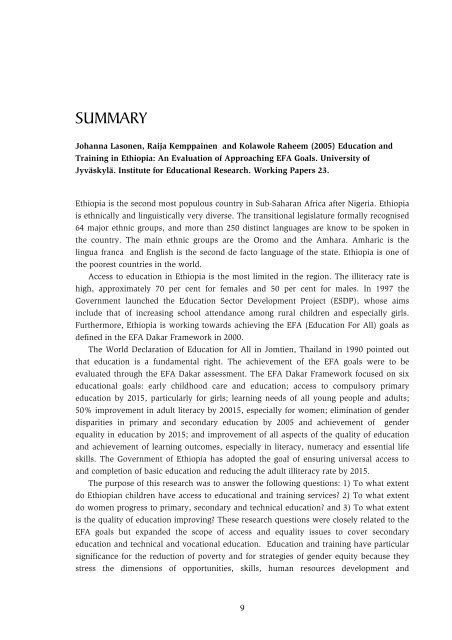Education and Training in Ethiopia An Evaluation of Approaching EFA Goals
Education and Training in Ethiopia - Koulutuksen tutkimuslaitos
Education and Training in Ethiopia - Koulutuksen tutkimuslaitos
- No tags were found...
You also want an ePaper? Increase the reach of your titles
YUMPU automatically turns print PDFs into web optimized ePapers that Google loves.
SUMMARYJohanna Lasonen, Raija Kemppa<strong>in</strong>en <strong>and</strong> Kolawole Raheem (2005) <strong>Education</strong> <strong>and</strong><strong>Tra<strong>in</strong><strong>in</strong>g</strong> <strong>in</strong> <strong>Ethiopia</strong>: <strong>An</strong> <strong>Evaluation</strong> <strong>of</strong> Approach<strong>in</strong>g <strong>EFA</strong> <strong>Goals</strong>. University <strong>of</strong>Jyväskylä. Institute for <strong>Education</strong>al Research. Work<strong>in</strong>g Papers 23.<strong>Ethiopia</strong> is the second most populous country <strong>in</strong> Sub-Saharan Africa after Nigeria. <strong>Ethiopia</strong>is ethnically <strong>and</strong> l<strong>in</strong>guistically very diverse. The transitional legislature formally recognised64 major ethnic groups, <strong>and</strong> more than 250 dist<strong>in</strong>ct languages are know to be spoken <strong>in</strong>the country. The ma<strong>in</strong> ethnic groups are the Oromo <strong>and</strong> the Amhara. Amharic is thel<strong>in</strong>gua franca <strong>and</strong> English is the second de facto language <strong>of</strong> the state. <strong>Ethiopia</strong> is one <strong>of</strong>the poorest countries <strong>in</strong> the world.Access to education <strong>in</strong> <strong>Ethiopia</strong> is the most limited <strong>in</strong> the region. The illiteracy rate ishigh, approximately 70 per cent for females <strong>and</strong> 50 per cent for males. In 1997 theGovernment launched the <strong>Education</strong> Sector Development Project (ESDP), whose aims<strong>in</strong>clude that <strong>of</strong> <strong>in</strong>creas<strong>in</strong>g school attendance among rural children <strong>and</strong> especially girls.Furthermore, <strong>Ethiopia</strong> is work<strong>in</strong>g towards achiev<strong>in</strong>g the <strong>EFA</strong> (<strong>Education</strong> For All) goals asdef<strong>in</strong>ed <strong>in</strong> the <strong>EFA</strong> Dakar Framework <strong>in</strong> 2000.The World Declaration <strong>of</strong> <strong>Education</strong> for All <strong>in</strong> Jomtien, Thail<strong>and</strong> <strong>in</strong> 1990 po<strong>in</strong>ted outthat education is a fundamental right. The achievement <strong>of</strong> the <strong>EFA</strong> goals were to beevaluated through the <strong>EFA</strong> Dakar assessment. The <strong>EFA</strong> Dakar Framework focused on sixeducational goals: early childhood care <strong>and</strong> education; access to compulsory primaryeducation by 2015, particularly for girls; learn<strong>in</strong>g needs <strong>of</strong> all young people <strong>and</strong> adults;50% improvement <strong>in</strong> adult literacy by 20015, especially for women; elim<strong>in</strong>ation <strong>of</strong> genderdisparities <strong>in</strong> primary <strong>and</strong> secondary education by 2005 <strong>and</strong> achievement <strong>of</strong> genderequality <strong>in</strong> education by 2015; <strong>and</strong> improvement <strong>of</strong> all aspects <strong>of</strong> the quality <strong>of</strong> education<strong>and</strong> achievement <strong>of</strong> learn<strong>in</strong>g outcomes, especially <strong>in</strong> literacy, numeracy <strong>and</strong> essential lifeskills. The Government <strong>of</strong> <strong>Ethiopia</strong> has adopted the goal <strong>of</strong> ensur<strong>in</strong>g universal access to<strong>and</strong> completion <strong>of</strong> basic education <strong>and</strong> reduc<strong>in</strong>g the adult illiteracy rate by 2015.The purpose <strong>of</strong> this research was to answer the follow<strong>in</strong>g questions: 1) To what extentdo <strong>Ethiopia</strong>n children have access to educational <strong>and</strong> tra<strong>in</strong><strong>in</strong>g services? 2) To what extentdo women progress to primary, secondary <strong>and</strong> technical education? <strong>and</strong> 3) To what extentis the quality <strong>of</strong> education improv<strong>in</strong>g? These research questions were closely related to the<strong>EFA</strong> goals but exp<strong>and</strong>ed the scope <strong>of</strong> access <strong>and</strong> equality issues to cover secondaryeducation <strong>and</strong> technical <strong>and</strong> vocational education. <strong>Education</strong> <strong>and</strong> tra<strong>in</strong><strong>in</strong>g have particularsignificance for the reduction <strong>of</strong> poverty <strong>and</strong> for strategies <strong>of</strong> gender equity because theystress the dimensions <strong>of</strong> opportunities, skills, human resources development <strong>and</strong>9




![to read the full report [pdf, Amharic] - Ethiopian Review](https://img.yumpu.com/52737829/1/190x245/to-read-the-full-report-pdf-amharic-ethiopian-review.jpg?quality=85)











